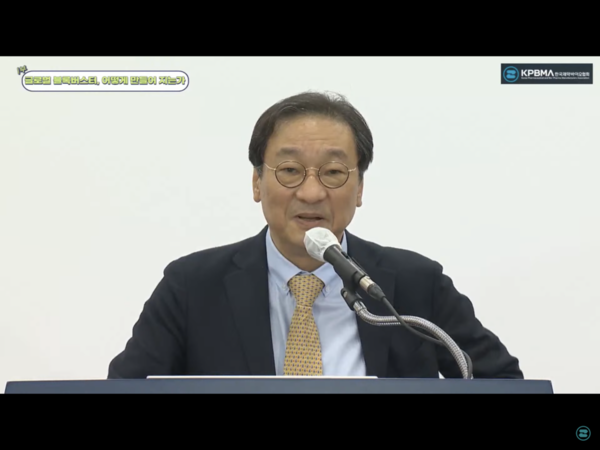The local pharmaceutical industry needs various funding tools like M&A and a megafund to develop a Korean blockbuster drug that can generate over $1 billion annually, an expert said.
At the “K-Blockbuster Global Forum,” organized by the Korea Pharmaceutical and Bio-Pharma Manufacturers Association (KPMBA) on Tuesday, industry experts and scholars presented strategies to develop a local novel drug. The forum was broadcast live on YouTube.
Professor Song Si-young of the Gastroenterology Division at the Severance Hospital offered a keynote speech on “Why K-Blockbuster Now.”

He opened the speech by mentioning that the Covid-19 pandemic led the entire globe to realize that it was important to have national self-sufficiency in medicines and medical devices.
A domestic drugmaker’s revenue used to be similar to that of Samsung Electronics in the 1970s. After over 40 years, however, most Korean pharmaceutical companies cannot even enter the global market, Song said.
“There were many reasons such as the small domestic market and the nation’s excessive reliance on imported drugs. But, the biggest reason was that the systematic national response to the global competition was poor,” he said.
According to Song, the Korean government’s pharmaceutical research support is scattered across the ministries or mostly invested in universities, while the U.S. focuses about 90 percent of the R&D budget on the National Institutes of Health to develop innovative projects.
Switzerland and the U.K. also have small domestic markets like Korea but produced multinational pharmaceutical firms such as Novartis, Roche, and AstraZeneca, Song said.
To nurture the Korean pharmaceutical industry, the government should meet the needs of the industry actively and change legal and institutional systems, he emphasized.
Song pointed out the problems of the Korean pharmaceutical industry such as the domination by multinational drugmakers, absence of a large local drugmaker, reliance on technology export rather than completion of new drug development, dependence on domestic generic drugs, preference for initial public offering without sales instead of M&A, preference for power transfer from owner to children, and lack of open innovation.
Unlike Korean biotech firms relying on IPO, multinational drugmakers created venture firms, licensed out pipelines, and sought M&As to continue growth and establish an environment to develop a blockbuster drug, Song went on to say.
“If the Korean pharmaceutical industry misses this opportunity when the potential is the greatest, it will be very difficult (to make a blockbuster medicine) in the future,” he said.
Huh Kyung-hwa, CEO of Korea Innovative Medicines Consortium (KIMCo), gave a presentation on the “Korean Blockbuster Drug Development Model.”
He said the local industry needs to improve new drug development efficiency and seek structural changes in the capital market for new drug development.
“Korean pharmaceutical and biotech industry’s focus is changing from generic drugs to R&D, from synthetic drugs to biopharmaceuticals, and from reliance on the domestic demand to entry into the global market,” Huh said.
According to Huh, the global pharmaceutical sector’s revenue is expected to reach 1,600 trillion won ($1,411 billion) in 2026, with innovative small and medium-sized enterprises (SMEs) driving the growth.
Among 53 new drugs authorized by the FDA in 2020, 26 or 52 percent of them were developed by SMEs, and 19 SMEs won the FDA nod for the first time, he said.
“From a global perspective, a Korean drug company is an SME,” Huh said. “If Korean companies first think about how to enter the overseas market with which portfolio and how to raise funds and conduct clinical trials, they have enough opportunities, too.”
He said Korea’s research efficiency for new drug development was relatively high, ranking 10th among the 20 OECD members. However, the nation’s development efficiency ranked low at 15th because many papers and patents did not lead to good clinical trials and approval results, he noted.
Such a problem occurred because there was an insufficient late-stage investment, which requires the most funds for blockbuster drug development, Huh said.
To resolve the issue, the industry needs a private-public partnership (PPP) that the private sector leads and the government supports and a megafund with pooled capital of $1 billion or more to focus on late-stage trials, he said.
Representative PPP examples include Europe’s Innovative Medicines Initiative (IMI), megafunds raised by Singapore’s sovereign wealth fund Temasek and a private fund by Blackstone investing in late-stage trials.
“A megafund is not a choice but a must,” Huh said. Domestic companies should shift focus from early-stage technology export to late-stage clinical trials, raise a megafund, and select drug candidates based on technological innovation and profitability to make a Korean blockbuster medicine.
“Pharmaceutical and biotech companies should form a consortium to create synergy effects in technology and drug development capacity.”

